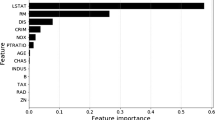Abstract
In this paper, we propose a more efficient Bayesian network structure learning algorithm under the framework of score based local learning (SLL). Our algorithm significantly improves computational efficiency by restricting the neighbors of each variable to a small subset of candidates and storing necessary information to uncover the spouses, at the same time guaranteeing to find the optimal neighbor set in the same sense as SLL. The algorithm is theoretically sound in the sense that it is optimal in the limit of large sample size. Empirical results testify its improved speed without loss of quality in the learned structures.
Similar content being viewed by others
References
Friedman N, Linial M, Nachman I, Pe’er D. Using Bayesian networks to analyze expression data. Journal of Computational Biology, 2000, 7(3–4): 601–620
Wang Z, Wang L, Tan S. Emergent and spontaneous computation of factor relationships from a large factor set. Journal of Economic Dynamics and Control, 2008, 32(12): 3939–3959
Yang J, Wang Z, Liu B, Tan S. Continuous variable based Bayesian network structure learning from financial factors. In: Proceedings of the 2012 IEEE Conference on Computational Intelligence for Financial Engineering & Economics. 2012, 1–6
Kuikka S, Varis O. Uncertainties of climatic change impacts in finnish watersheds: a Bayesian network analysis of expert knowledge. Boreal Environment Research, 1997, 2(1): 109–128
Spirtes P, Glymour C N, Scheines R. Causation Prediction & Search 2e, Volume 81. MIT press, 2000
Pearl J. Causality: models, reasoning and inference, Volume 29. Cambridge University Press, 2000
Silander T, Myllymaki P. A simple approach for finding the globally optimal Bayesian network structure. arXiv preprint arXiv:1206.6875, 2012
Teyssier M, Koller D. Ordering-based search: a simple and effective algorithm for learning Bayesian networks. arXiv preprint arXiv:1207.1429, 2012
Aliferis C, Statnikov A, Tsamardinos I, Mani S, Koutsoukos X. Local causal and Markov blanket induction for causal discovery and feature selection for classification, Part i: Algorithms and empirical evaluation. The Journal of Machine Learning Research, 2010, 11: 171–234
Niinimaki T, Parviainen P. Local structure discovery in Bayesian networks. In: Proceedings of the 28th Annual Conference on Uncertainty in Artificial Intelligence (UAI-12). 2012, 634–643
Tsamardinos I, Aliferis C, Statnikov A. Time and sample efficient discovery of Markov blankets and direct causal relations. In: Proceedings of the 9th ACMSIGKDD International Conference on Knowledge Discovery and Data Mining. 2003, 673–678
Koller D, Sahami M. Toward optimal feature selection. Proceedings of the 13th International Conference on Machine Learning. 1996, 284–292
Friedman N, Nachman I, Peér D. Learning Bayesian network structure from massive datasets: the “sparse candidate” algorithm. In: Proceedings of the 15th Conference on Uncertainty in Artificial Intelligence. 1999, 206–215
Aliferis C F, Tsamardinos I, Statnikov A. Hiton: a novel Markov blanket algorithm for optimal variable selection. In: Proceedings of the 2003 Association of Moving Image Archivists Annual Symposium. 2003, 21–25
Tsamardinos I, Brown L E, Aliferis C F. The max-min hill-climbing Bayesian network structure learning algorithm. Machine learning, 2006, 65(1): 31–78
Koller D, Friedman N. Probabilistic Graphical Models: Principles and Techniques. MIT press, 2009
Tsamardinos I, Statnikov A, Brown L E, Aliferis C F. Generating realistic large Bayesian networks by tiling. In: Proceedings of the 19th International FLAIRS Conference. 2006, 592–597
Author information
Authors and Affiliations
Corresponding author
Additional information
Jianjun Yang is a PhD candidate in the Center for Information Science at Peking University, China. His research focus centers around theoretical and applied machine learning. His theoretical interests are in probabilistic graphical models and high dimensional statistics.
Yunhai Tong received his BS and MS in computer science from Petroleum University of China, in 1993 and 1996 respectively. He received his PhD in computer science from Peking University, China in 2002. He is currently an associate professor in the Department of Machine Intelligence and the Key Laboratory of Machine Perception (Ministry of Education) at Peking University, China. His current research interests include data warehousing, online analytical processing, and data mining.
Zitian Wang received his PhD in electrical engineering from Peking University, China in 2009. He is a researcher in the Agricultural Bank of China. He is interested in the application of novel algorithms of artificial intelligence in investment, banking, and management.
Shaohua Tan received his PhD in electrical engineering from Katholieke Universiteit Leuven, Belgium in 1987. He has been professor in Center for Information Science, Peking University, China for 13 years. He has held various teaching and research positions in a number of countries prior to joining Peking University. His research interests include developing qualitative modeling techniques in modeling complex real-world systems and analysis of financial systems using AI techniques.
Rights and permissions
About this article
Cite this article
Yang, J., Tong, Y., Wang, Z. et al. Efficient and effective Bayesian network local structure learning. Front. Comput. Sci. 8, 527–536 (2014). https://doi.org/10.1007/s11704-014-3335-z
Received:
Accepted:
Published:
Issue Date:
DOI: https://doi.org/10.1007/s11704-014-3335-z




